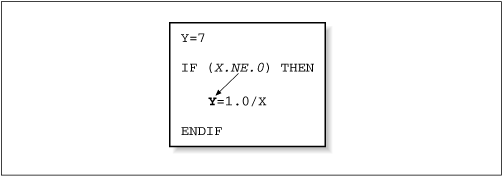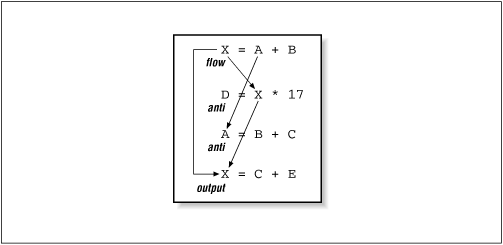
© O'Reilly Publishers (Used with permission)
This URL is http://www.stewart.cs.sdsu.edu/cs575/lecs/ch09.html
Section III of our text will cover:
Review Class Calendar
Review Class Assignments (with dates now)
You are have looked at a computational experiment involving Linear Algebra and you may find the the following document (which we first examined during Lab 15Sept03):
You also just completed working on timing the solution of
Let's use the following sample loops to focus our attention today:
do i=1,n a(i) = x(i) + y(i) d(i) = x(i) * f(i) end doOn a scalar computer, the order of computation would be
On a vector computer, the order of computation would be
a(1), a(2), a(3), ..., a(n), then d(1), d(2), d(3), ..., d(n)
Does the ordering make a difference above? [not in this example]. But there are many different computing platforms that have been characterized by Michael Flynn:
Fig. 12.10 Flynn's Taxonomy
Michael Flynn's Taxonomy
© O'Reilly Publishers (Used with permission)
Flynn's Taxonomy, a more
descriptive diagram from csep1.phy.ornl.gov/gif_figures/caf4.gif
Our goal is to understand the tasks the compiler performs on our behalf when we use the IBM Blue Horizon. The accounts are being created for us now and will be distributed after we have had our class group presentations and discussion on computer security.
Scalable Parallel Architectures and Their Software (especially note slide #34, #41 and #42) from the August 2002 NPACI Workshop. We also will become familiar with NPACI Architectures (especially note slide #3, #9 and #13), from the August 2003 NPACI Workshop at the San Diego Supercomputer Center. The first slides should be somewhat familiar concepts. It is the goal of this course to develop your understanding with the ones.
Fig. 9-1 Control dependency

© O'Reilly Publishers (Used with permission)
Due to the Control-structure of the If statement, the
compiler is unable to predict if the variable Y will
be reset by Y = 1.0/X.
Think about this code fragment,
is there a better way to avoid a possible divide by zero?

Flow dependencies (or backward dependencies) are defined on p. 183 where our text states they are common in Gaussian elimination. The text provides the example:
DO I=2,N A(I) = A(I-1) + B(I) END DOby replicating code, we can reduce the dependency, with an extra addition.
DO I=2,N,2 A(I) = A(I-1) + B(I) A(I+1) = A(I-1) + B(I) + B(I+1) END DOallowing the computation of A(2), A(3) then A(4), A(5), a modest increase in parallelism.
Antidependency is defined on p. 184 with the example below. "You must be sure that the instruction that uses A(I+2) does so before the previous one redefines it."
DO I=1,N A(I) = B(I) * E B(I) = A(I+2) * C END DO"We can directly unroll the loop and find some parallelism:"
Output dependency is defined on p. 185 as "getting the right values to the right variables when all the calculations have been completed."
Dependencies Within an Iteration
DO I=1,N D = B(I) * 17 A(I) = D + 14 ENDDOThe variable D has a flow dependency and delays the execution of the second statement in the loop. This will limit parallelism and closer examination, manually unrolling the loop several times shows
D = B(I) * 17 A(I) = D + 14 D = B(I+1) * 17 A(I+1) = D + 14 D = B(I+2) * 17 A(I+2) = D + 14revealing the variable D has flow, output and antidependencies. The technique to ensure parallelization, at the cost of some memory, is to promote the scalar to a vector
DO I = 1,N D(I) = B(I) * 17 A(I) = D(I) + 14 ENDDO
Some additional examples not covered in our text,
DO I=1,N C(I) = D(I) * C(INDEX(I)) END DOThe compiler cannot determine if C(INDEX(I)) is a recurrence, so this won't be vectorized. Note: Suppose the programmer knows that the INDEX will not bring in an recurrence. The programmer can share this knowledge with the compiler through a compiler directive:
$IVDEP DO I=1,N C(INDEX(I)) = D(I) * B(INDEX(I)) END DO
Loop Splitting
DO I=1,N A(I) = X(I) + Y(I) + INTERP(X(I)) B(I) = SIN(X(I)) + Z(I) END DO
This loop cannot be vectorized due to the subprogram all INTERP. But, if we split the loop,
DO I=1,N A(I) = X(I) + Y(I) + INTERP(X(I)) END DO DO I=1,N B(I) = SIN(X(I)) + Z(I) END DONow the first loop still does not vectorize, but the second one is a vector loop.
Loop Fusing Consider two loops with similar ranges of indices:
DO I=1,N A(I) = X(I) + Y(I) END DO DO I=1,N-1 B(I) = X(I) + Z(I) END DOWe can reduce loop overhead and memory references compared to the number of floating point operations by
DO I=1,N-1 A(I) = X(I) + Y(I) B(I) = X(I) + Z(I) END DO A(N) = X(N) + Y(N)
Fig. 9-5 Multiple dependencies

© O'Reilly Publishers
(Used with permission)